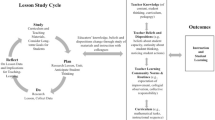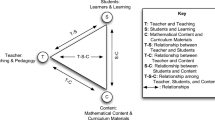Abstract
In their examination of elementary science classrooms, Amerine and Bilmes (1988) found that following instructions requires students to understand the relationship between the projected outcome and the corresponding course of actions. One of the most important resources for instructions is the lesson plan, which prescribes the sequence of teaching. However, there is often a gap between what is planned and what actually happens in the classroom. This raises the question of how teachers come to terms with contingent variants and unexpected outcomes that real-time interactions occasion and how lesson plans are configured into these processes. This study examines a teacher education program that uses lesson plans as a central resource for teaching mathematics. The results suggest that classroom teachers use lesson plans as communicative resources to identify problems, specify assumptions about their teaching and act on the evolving contingency of classroom interaction. The interactional contingency is the locus of teaching practices, not an obstacle to the application of procedures in lesson plans.




Similar content being viewed by others
References
Amerine, R., & Bilmes, J. (1988). Following instruction. Human Studies, 11, 327–339.
Ballou, D., & Podgursky, M. (2000). Reforming teacher preparation and licensing: What is the evidence? Teachers College Record, 102(1), 5–27.
Berliner, D. (2005). The near impossibility of testing for teacher quality. Journal of Teacher Education, 56(3), 205–213.
Bogdan, R., & Biklen, K. (2007). Qualitative research for education: An introduction to theory and methods. New York: Pearson.
Borko, H., & Livingston, C. (1989). Cognition and improvisation: Differences in mathematics instruction by expert and novice teachers. American Educational Research Journal, 26(4), 473–498.
Carlsen, W. (1991). Questioning in classrooms: A sociolinguistic perspective. Review of Educational Research, 61(2), 157–178.
Cazden, C. (2001). Classroom discourse: The language of teaching and learning (2nd ed.). Portsmouth, NH: Heinmann.
Chokshi, S., & Fernandez, C. (2005). Reaping the systemic benefits of lesson study: Insights from the U.S. Phi Delta Kappan, 86(9), 674–680.
Cochran-Smith, M., & Fries, K. (2005). Researching teacher education in changing times: Politics and paradigms. In M. Cochran-Smith & K. Zeichner (Eds.), Studying teacher education: The report of the AERA panel on research and teacher education (pp. 69–109). Mahwah, NJ: Lawrence Erlbaum.
Cohen, D. (1996). Standards-based school reform: Policy, practice, and performance. In H. F. Ladd (Ed.), Holding schools accountable: Performance-based reform in education. Washington, DC: Brookings Institution.
Darling-Hammond, L. (2000). Studies of excellence in teacher education. Washington, DC: American Association of Colleges for Teacher Education.
Desimone, L., Porter, A., Garet, M., Yoon, K., & Birman, B. (2002). Effects of professional development on teachers’ instruction: Results from a three-year longitudinal study. Educational Evaluation and Policy Analysis, 24, 81–112.
Eisenhart, M. (2001). Educational ethnography past, present, and future: Ideas to think with. Educational Researcher, 30(8), 16–27.
Erickson, F. (1982). Classroom discourse as improvisation: Relationships between academic task structure and social participation structure in lessons. In L. Wilkinson (Ed.), Communicating in the classroom (pp. 153–181). New York: Academic Press.
Erickson, F. (1986). Qualitative methods in research on teaching. In M. C. Wittrock (Ed.), Handbook of research on teaching (pp. 119–161). New York: Macmillan.
Fernandez, C. (2002). Learning from Japanese approaches to professional development: The case of lesson study. Journal of Higher Education, 53(5), 393–405.
Garfinkel, H. (1967). Studies in ethnomethodology. Cambridge: Polity Press.
Goodwin, C. (2000). Practices of seeing: Visual analysis: An ethnomethodological approach. In T. van Leeuwen & C. Jewitt (Eds.), Handbook of visual analysis (pp. 157–182). London: Sage.
Green, J., & Dixon, C. (2002). Exploring differences in perspectives on microanalysis of classroom discourse: Contributions and concerns. Applied Linguistics, 23(3), 393–406.
Heap, J. (1982). Understanding classroom events: A critique of Durkin, with an alternative. Journal of Reading Behavior, 45(4), 391–411.
Heap, J. (1990). Applied ethnomethodology: Looking for the local rationality of reading activities. Human Studies, 13(1), 39–72.
Heaton, R. (2000). Teaching mathematics to the new standards: Relearning the dance. New York: Teachers College Press.
Heritage, J. (1984). Garfinkel and ethnomethodology. Cambridge: Polity Press.
Komoski, P. K. (1977). Instructional materials will not improve until we change the system. Educational Leadership, 42, 31–37.
Lee, Y.-A. (2006). Towards respecification of communicative competence: Condition of L2 instruction or its objective? Applied Linguistics, 27(3), 349–376.
Lee, Y.-A. (2010). Learning in the contingency of talk-in-interaction. Text & Talk, 30(4), 403–422.
Lewis, C., Perry, R., & Murata, A. (2006). How should research contribute to instructional improvement? The case of lesson study. Educational Researcher, 35(3), 3–14.
Lynch, M. (1993). Scientific practice and ordinary action. New York: Cambridge.
Lynch, M. (2006). Cognitive activities without cognition? Ethnomethodological investigations of selected “cognitive” topics. Discourse Studies, 8(1), 95–104.
Macbeth, D. (2000). Classroom as installations: Direct instruction in the early grades. In S. Hester & D. Francis (Eds.), Local educational order: Ethnomethodological studies of knowledge in action (pp. 21–72). Philadelphia: John Benjamins.
Macbeth, D. (2003). Hugh Mehan’s “learning lessons” reconsidered: On the differences between the naturalistic and critical analysis of classroom discourse. American Educational Research Journal, 40(1), 239–280.
Maxwell, J. (2004). Causal explanation, qualitative research, and scientific inquiry in education. Educational Researcher, 33(2), 3–11.
Mehan, H. (1979). Learning lesson. Cambridge, MA: Harvard University Press.
Moerman, M., & Sacks, H. (1971/1988). On understanding in the analysis of natural conversation. In M. Moerman (Ed.), Talking culture: Ethnography and conversation analysis (pp. 180–186). Philadelphia, PA: University of Pennsylvania Press.
Mullis, I., Martin, M. O., Gonzales, E. J., Gregory, K. D., Garden, R. A., O’Connor, K. M., M., Chrostowski, S., & Smith, T. (2000). TIMSS International mathematics report. Chestnut Hill, MA: TIMSS & PIRLS International Study Center.
Page, R. (2000). The turn inward in qualitative research. Harvard Educational Review, 70(1), 23–38.
Perry, R., & Lewis, C. (2009). What is successful adaptation of lesson study in the US? Journal of Educational Change, 10, 365–391.
Remillard, J. (1999). Curriculum materials in mathematics education reform: A framework for examining teachers’ curriculum development. Curriculum Inquiry, 29(3), 315–342.
Remillard, J. (2005). Examining key concepts in research on teachers’ use of mathematics curricula. Review of Educational Research, 75(2), 211–246.
Sacks, H. (1992). Lectures on conversation. Cambridge: Blackwell.
Sacks, H., Schegloff, E., & Jefferson, G. (1974). A simplest systematics for the organization of turn-taking for conversation. Language, 50(4), 693–735.
Schegloff, E. (1996). Issues of relevance for discourse analysis: Contingency in action, interaction and co-participant context. In E. H. Hovy & D. R. Scott (Eds.), Computational and conversational discourse: Burning issues—an interdisciplinary account (pp. 3–35). New York: Springer.
Schegloff, E., Jefferson, G., & Sacks, H. (1977). The preference for self-correction in the organization of repair in conversation. Language, 53(2), 363–382.
Sharrock, W., & Anderson, B. (1982). Talking and teaching: Reflective comments on in-classroom activities. In G. Payne & E. C. Cuff (Eds.), Doing teaching: The practical management of classrooms (pp. 170–183). London: Batsford Academic and Educational.
Stephens, W. M. (1982). Mathematical knowledge and school work: A case study of the teaching of developing mathematical processes. Unpublished doctoral dissertation. Madison: University of Wisconsin.
Stigler, J., & Hiebert, J. (1999). The teaching gap. New York: The Free Press.
Suchman, L. (1987). Plans and situated actions: The problem of human machine communication. New York: Cambridge University Press.
van Lier, L. (1988). The classroom and the language learner. London: Longman.
Wang-Iverson, P., & Yoshida, M. (Eds.). (2005). Building our understanding of lesson study. Philadelphia: Research for Better Schools.
Wideen, M., Mayer-Smith, J., & Moon, B. (1998). A critical analysis of the research on learning to teach: Making the case for an ecological perspective on inquiry. Review of Educational Research, 68, 130–178.
Yinger, R. (1987). By the seat of your pants: Inquiry into improvisation and teaching. Paper presented at the American Educational Research Association, Washington, DC.
Yon, D. (2003). Highlights and overview of the history of educational ethnography. Annual Review of Anthropology, 32, 411–429.
Zeichner, K. (2005). Teacher education programs. In M. Cochran-Smith & K. Zeichner (Eds.), Studying teacher education: The report of the AERA panel on research and teacher education (pp. 645–735). Mahwah, NJ: Lawrence Erlbaum.
Zimmerman, D., & Pollner, M. (1970). The everyday world as a phenomenon. In J. Douglas (Ed.), Understanding everyday life (pp. 80–103). Chicago: Aldine.
Acknowledgments
We are grateful to the classroom teachers for allowing us to observe and record their teaching and discussions. This research was supported by a grant from the Spencer Foundation (#200700152).
Author information
Authors and Affiliations
Corresponding author
Rights and permissions
About this article
Cite this article
Lee, YA., Takahashi, A. Lesson Plans and the Contingency of Classroom Interactions. Hum Stud 34, 209–227 (2011). https://doi.org/10.1007/s10746-011-9181-1
Published:
Issue Date:
DOI: https://doi.org/10.1007/s10746-011-9181-1




